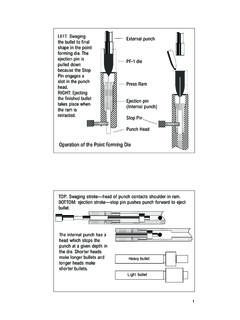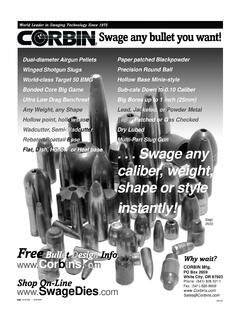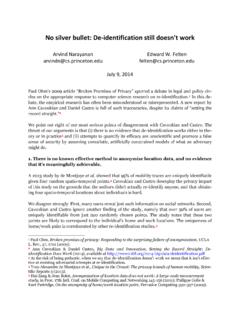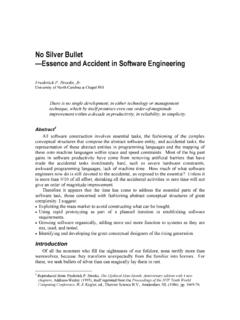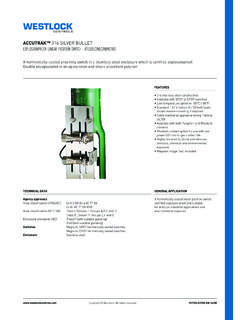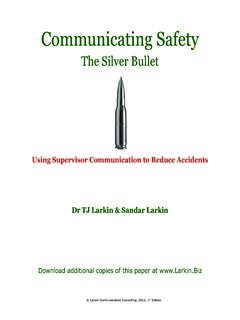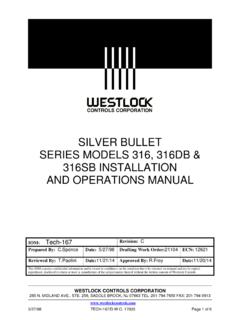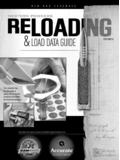Transcription of The Business of Custom Bullet Swaging
1 The Business of Custom Bullet Swaging Dave Corbin, PresidentCorbin Manufacturing & Supply, 'm going to assume that you are already somewhat knowledgableabout Bullet casting -- making simple lead bullets by pouring moltenlead alloy into split moulds and then letting it cool and solidify, thenputting the bullets through a lubricator and sizer machine to apply athick Bullet lubricant and adjust the diameter. Everything about the cus-tom Bullet Business is exactly opposite of the casting , cast bullets are popular because they are low cost. Theymust be made in vast quantities, therefore, to produce a reasonableprofit, meaning that you must invest in large volumes of material andprocess it in a very short period of time. High speed and high volumerequires a large market. Therefore, a successful Bullet casting businessalways tries for the police department bids, sales to volume ammuni-tion loaders, and shooters whose primary concern is getting a lot ofammo at the cheapest price.
2 Performance is not as important as lowcost. The average cast Bullet sells for less than five cents and is pack-aged in lots of set up for this volume production generally will cost about$15,000, and at a profit of one and a half cents per Bullet , will requireone million bullets sold in order to amortize the cost of equipment. Atypical set-up might produce 1,000 bullets per hour, which would meansales from 1,000 hours would cover the cost of machinery if there wereno other expenses (of course, labor and overhead will extend this pay-back time). This would consume the profits from selling the bullets pro-duced in 25 weeks of operation (a little over half a year).In contrast, Custom swaged bullets are in demand because theyoffer something that can't be purchased for any price from the facto-ries. The buyers are scattered over the world, not concentrated in onesmall local area, and they develop intense loyalty to the brand ratherthan being overly concerned about price.
3 The successful Custom bul-let maker always trys for a special market niche, where word-of-mouthreputation will bring sales by mail from all corners of the Earth. Inno-vation is prized in direct regard to how it promises to solve a particularproblem. Exceptional performance, unusual calibers and weights, andspecial designs are the keys to this market, rather than high volume andlow price. The average Custom Bullet sells for over one dollar per bul-let, and is packaged in lots of 20 to average investment in a Custom Bullet Business is $7,500. Theaverage gross profit on a Custom Bullet that sells for one dollar is 80%.Therefore, it would take the profit from the sale of 9,375 bullets to payfor the machinery. Custom bullets are made precisely, and carefully, ata rate of about 100 per hour (average, between 30 and 400 per hourdepending on the complexity -- the range of possible Bullet designs isnearly infinite compared to casting). This would mean that the equip-ment would be paid completely from the profits produced over a pe-riod of hours, or you could be assured of enough market to consume your produc-tion of 100 per hour per person, then you would always have a grossincome of $80 per hour per machine.
4 Subtract the wages (say, $10 perhour) and you have $70 left. Subtract the shop overhead (phone, lights,advertising costs) and you have probably got at least $50, since mostswaging operations don't cost you more than $20 per hour Custom Bullet operations are run from the home, becausethey are relatively quiet and "invisible" to the outside world -- no firehazzard, no fumes or smoke, low enough volume so that trucks don'tpull in at all hours of the day and the daily production can be placed onthe car seat and taken to the post office or to UPS. Only a FFL class 6license is actually required to sell bullets. This eliminates almost all theregulatory problems from OSHA, city, county and state is no fire hazzard, no smoke and fumes. The neighbors have noidea anything is even being done next , figure your net profit per machine on cast bullets. It is highlyunlikely that it will be anywhere close to $50 per hour. Very few castbullet company owners are driving cars that look like they belong to aperson who earns $100,000 a year (which is what working at $50/hr.)
5 Ina normal 40-hour week would produce). The few who do generallyhave more than one machine making bullets and are on a very fastproduction treadmill, extremely competitive, and vunerable to lowercost competitors who might not even survive before causing a fatalloss of sales with their lower Bullet caster focuses on high volume. The Bullet swager focuses onhigh profit. The Bullet caster is highly visible, is subject to fire and healthregulations because of the hot lead and fumes, must do a huge volumeto make a living, and faces constant competition from hundreds of otherwould-be Bullet casters because the simple technology is well under-stood by virtually every handloader. Almost anyone who wants to starta home Business and likes guns probably trys to sell cast bullets at sometime. Doing it right may not be as easy as they think, but that doesn'tstop them from trying. Meanwhile, since volume is king, and bulletsper hour is the driving force behind the Business , anyone who managesto take away a big client takes a sizable chunk of the operating Business is vunerable to this sort of competition precisely becauseit does large volume sales at low Bullet swager is virtually invisible, has little or no concern aboutregulatory agencies, and needs only to reach out to the specializedmarket in order to make a living.
6 This means reaching people who arenot clustered locally, but who are scattered everywhere. To do this re-quires either national and international distributors, magazine adver-tising and promotion, or word-of-mouth reputation. All three can beused effectively. The best way to reach specialized clients is to usepress releases and publicity contacts (new product news, gun writers,builders of related firearms who need supplier sources for their clients,well-known shooters or those about to become well known, and similarpromotional efforts).The major stumbling block for the would-be Custom Bullet maker isunderstanding how to reach potential clients. Most people think morealong the lines of the person who casts bullets for a living: they areshooters and want to pay as little as possible for the Bullet , so theynaturally assume everyone does. That leads to a serious error in think-ing which blocks most people off from the serious money: a personwho trys to organize his Business as though he were the consumer willfocus on making as little profit as possible, inadvertently!
7 After all, if you want to make a large volume of bullets and sell themat very competitive prices, when there are other options open, you arereally saying you want to put in a large investment, work very hard, andsee as little return on it as possible! Think about it: the main thing youwant is to make as many bullets an hour as you can, and then to sellthem for only pennies. The cheaper you sell them, the more competi-tive you'll be, and the more you'll need to make in order to show areasonable profit. The ultimate end of this thinking is giving away thebullets free to anyone who wants them!By contrast, if you consider how the Swaging Business works, it isgeared to making unique, special products that a smaller number ofshooters will pay a large amount to obtain. You will have virtually nocompetition based on price, since the people who don't want exoticbullets are certainly not part of your market base, and those who doalready understand they will have to pay a fair price for your all, there are over 200 other Custom Bullet makers, stretching backat least 20 years with excellent reputations and advertised prices thathave made it quite clear what Custom bullets cost.
8 No one who is seri-ously considering buying Custom bullets has a problem with the main thing you want to do is to make the best possible Bullet fora given purpose, so that you'll own that particular piece of the marketand new-comers will find it almost impossible to get your clients toswitch their loyalty. This is in fact what happens: thousands of shoot-ers today won't consider anything but their favorite specialty Bullet , beit a Trophy Bonded, Swift A-Frame, Glaser Safety Slug, or any of ourother commercial clients' number of bullets you make per hour is far down the list ofimportance, compared to the profit you get per Bullet and the intenseloyalty you manage to develop from your clients. The ultimate extremeof this path would be making one Bullet a year for $100,000, which ofcourse is just as silly as giving them except it would be a wholelot more profitable! But you can get close to this kind of money in thisway: hone in on specialty markets which cater to wealthy Corbin client found a market in England when he approachedseveral of the famous old-time British gun-makers with the suggestionthat he might make some of the obsolete caliber bullets for them.
9 Theytold him they didn't even make ammunition for the same guns theyproduced today, but depended on Custom loading firms and the clientsto provide their own!"Even for guns like these $150,000 gold and silver inlaid .600 Nitroand nearly one-of-a-kind .700 Nitro", he asked?"Yes", they said. "Even for those. They are for collectors."The idea struck him that maybe people who paid large sums forfancy guns might want to shoot them, and perhaps they'd pay a largeprice for bullets, to impress other wealthy friends by letting them shoota few very costly rounds. He made some .700 Nitro bullets, some .600 Nitros, and a few other odd rounds that a handful of people have gunsto shoot. He managed to get a list of clients who had purchased theseguns, and sent them a fancy flyer, for which he spared little flyer advertised the finest bullets in the world for these calibers, atprices from $50 to $100 PER Bullet ! Outrageous, you say?Today, he makes a good living catering to people who own theseguns.
10 Even at two bullets per hour, he can make more money thanmost cast Bullet firms see in a lifetime. The .700 Nitro Bullet probablyhas about twenty-five cents worth of material in it. You figure the per-centage of profit: it's "world-class", as Ross Perot would say. How im-portant, then, is the number of bullets per hour?It only proves once again that the direction you are headed withcustom swaged bullets is far more desirable than with casting, and thatit is attainable, even at the levels that approach the extreme. I wouldcertainly not suggest there is room for another person to make .700 Nitro bullets. But it would be just as foolish to suggest that there isnothing between that, and the self-imposed treadmill of high volume,low profit production. There are all possible levels in that sell for $25, $10, $5, $ , and $ each are beingmade as you read this. The more they cost, the smaller and more selectis the market. But the curve of profit versus volume still producesroughly the same net income at all these levels.
